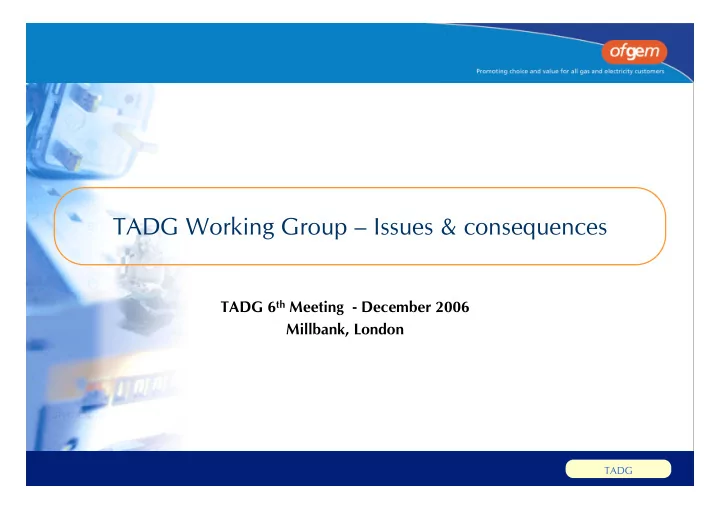

TADG Working Group – Issues & consequences TADG 6 th Meeting - December 2006 Millbank, London TADG
Approach adopted in TADG � Views expressed at first meeting on the need for assessment of issues/ problems with the current arrangements and to better understand process of development of agency models � Ofgem developed proposed framework set out at Meeting 2 � Discussed the issues/ problems associated with growth of DG in next three meetings in the context of: – Operation & planning – Access & charging � A number of agency models have been proposed by the group TADG
Summary of issues raised The following issues / problems and associated consequences � have been raised by at least one party in a TADG meeting: 1. small DG bypassing GB queue, impacting on other users 2. accuracy of information available to NGET on growth of small DG, impact on transmission investment 3. gap in contractual framework for exports from non-BEGA DG, impact on rights & obligations 4. growth of non-BEGA DG / DG not actively participating in BM, impact on constraint management 5. perverse incentives from differential treatment in transmission charging for DG under 100MW 6. cost-reflectivity of differential treatment in transmission charging for DG under 100MW TADG
Issue 1: Impact on GB queue � Issues – No contractual arrangements between NGET and any party in relation to energisation of new small DG connections not covered by CAP097 – implications for availability of transmission capacity for other users � Consequences – perverse incentives to size DG below upper threshold for small power station to get earlier connection date – growth of DG reduces availability of transmission capacity which may be allocated to other users, and may trigger requirement for transmission reinforcement TADG
Issue 2: Information available to NGET � Issues – No contractual arrangements between NGET and any party in relation to energisation of new small DG connections not covered by CAP097 – implications for information provision to NGET in planning timescales and for signals on NGET to invest in the transmission system � Consequences – NGET have visibility of DG connections through DNO week 24 data but have concerns on data accuracy and volatility and its use as a basis for investment decisions TADG
Issue 3: Rights/obligations of non-BEGA DG � Issues – Gap in contractual framework in relation to exports from the distribution system to transmission system not associated with BEGA DG – implications for transmission rights and obligations of affected users � Consequences – No compensation mechanism for curtailment of transmission access for non-BEGA DG – Exports from the distribution system to the transmission system and output from non-BEGA DG not explicitly covered in the transmission charging methodology TADG
Issue 4: Impact on constraint management � Issues – No formalised procedure for NGET to constrain down DG not actively participating in BM – implications for system operation � Consequences – Boundary overloads exacerbated or more difficult to manage – NGET currently constrain plant with TEC instead, or enter commercial balancing services agreements on bilateral basis with individual DG TADG
Issue 5: Perverse incentives � Issues – DG treated as either transmission-connected generation or as negative demand in transmission charging, based on size threshold criteria – implications for size/voltage-related incentives � Consequences – TNUoS charging size threshold creates commercial incentive on DG to size below 100MW to receive embedded benefits rather than pay charges – Embedded benefits similarly create commercial incentive on generators below 100MW to connect to distribution network rather than the transmission network – The trade-off between embedded benefits and exposure to distribution charges is another relevant factor in this choice TADG
Issue 6: Cost-reflectivity � Issues – DG treated as either transmission-connected generation or as negative demand in transmission charging, based on size threshold criteria – implications for cost-reflectivity � Consequences – avoided transmission investment is not proportional to TNUoS embedded benefit – new DG connections may trigger transmission infrastructure reinforcement without being charged TNUoS – BEGA DG have same product (TEC) as transmission-connected generation but don’t pay generation TNUoS unless over 100MW TADG
Materiality � The government has set targets of 10GW of installed CHP capacity by 2010 and 10% of electricity sold by suppliers to be sourced from renewable fuels – mostly likely to impact on DG � In February 2006, Ofgem requested data on growth of DG � Data indicated by 2010: – an additional 7.2GW of DG – an additional 10GW of directly connected transmission – additional demand of around 3GW � Net position: increase in DG > increase in demand TADG
Promoting choice and value for all gas and electricity customers TADG
Recommend
More recommend